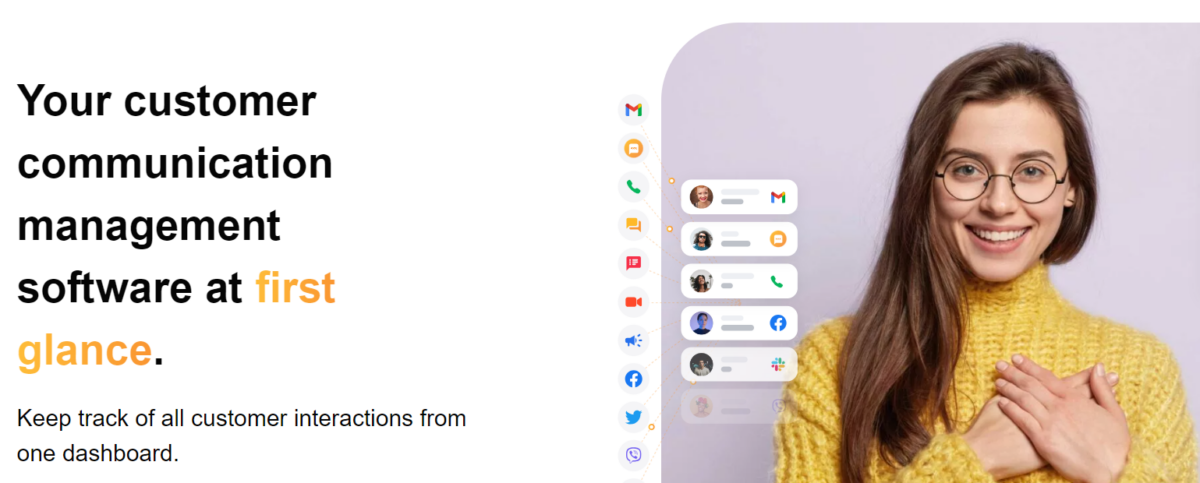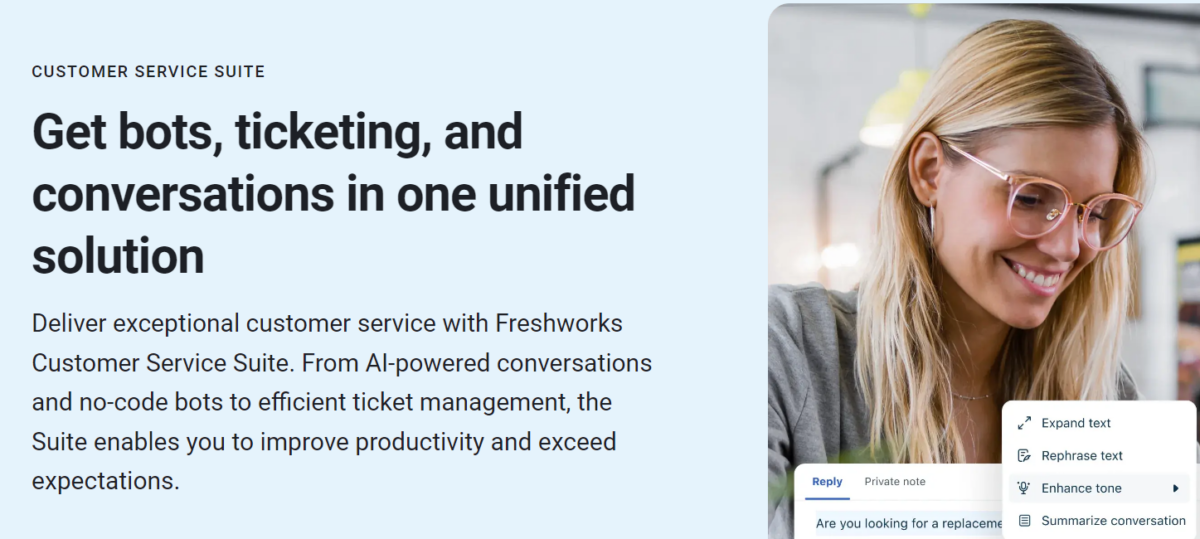Customer communication management (CCM) solutions provide a business with a great opportunity to build a loyal customer base by enhancing communications across different channels.
The need to stand out in this modern business world filled with competition is high.
A few miss here and there, and you risk losing your customers to your competitors.
According to a report, 92% of surveyed consumers will switch to a different company after three or fewer bad experiences, while 26% of them will switch after only one bad experience.
So, if you don’t want to lose your customers, it’s high time you focus on providing better experiences to them.
One way to do that is by improving your communications with them.
And that’s what CCM is all about.
In this article, I’ll discuss CCM, its advantages, and some effective CCM strategies.
What Is Customer Communication Management (CCM)?
Customer communication management (CCM) is a process of managing all the outbound communications between an organization and its customers.


Now, you may ask, “How does communication management work?”
CCM deals with how you create, share, deliver, store, and manage customer messages across different communication channels (both printed and online) for marketing, running promotions and sales, product introductions, notifications, renewals, and so on. The communication channels can include:
- Printed documents such as faxes, user manuals, flyers, press releases, etc.
- Direct communications through phone calls
- Virtual messages through emails, chatbots, social media messages, etc.
Furthermore, CCM tools are software using which you can manage your customer communications. It will provide a broader view of all the interactions with your customers from different channels and record relevant information.
The aim of CCM is to improve your outbound communications, offer better support and service to customers, enhance customer experience, and improve relationships with your partners, distributors, and regulatory compliance bodies.
Benefits of Customer Communication Management


- Better customer experiences by understanding their pain points and working on them
- Boost customer engagement and interactions by offering self-service options like guides, knowledge base, etc.
- Customer loyalty by staying connected with them after sales with the help of powerful messages
- Improved revenue and sales by working on customer feedback
Customer Communication Management Strategies
Here are some customer communications management strategies:
Effective Planning
Before implementing CCM in your organization, you must effectively plan the whole process in advance. A good CCM plan will help you streamline your processes, deliver outstanding customer experience, and bring you better results.
For effective planning:
- Define your organization’s goals and set up tailored communications in order to boost sales, retention, and customer loyalty.
- Find out who your target customers are based on their purchase history, interests, location, age, etc., to categorize them and segment them for personal interactions with them.
- Opt for effective communication channels like email, social media, SMS, etc. Choose at least 2-3 channels where your target audience mostly hangout.
- Understand your customers’ journey with your brand and reach out to them with targeted, meaningful interactions.
- Know when to follow up and ensure that you offer consistent experiences to customers in each interaction across all channels.
- Keep a content calendar to organize and manage all activities related to communications like content, time, channels, customers, etc.
Personalization
Modern customers want you to cover the extra mile and delight them with personalized experiences while sending generic messages that hardly resonate well with them.


So, listen to what your customers have to say and give them the experience they expect from you. To do that, track customer communications, take customer feedback, and conduct surveys and polls to understand your customers. Now, analyze this data to gain powerful insights for personalization.
Here are some examples of customer communication management for personalization:
- Send your customers discounts and offers to make them feel special on certain occasions like birthdays and anniversaries
- Offer them personalized product recommendations according to their preferences,
While personalizing your messages, keep in mind the unique needs and likes of each customer so that they would love engaging with it and remember you always.
Implement Automation
Tracking everything manually, from customers and channels to communications and messages, could be difficult, time-consuming, and error-prone.
Implementing automation in your communication strategy enhances the efficiency and accuracy of your workflows and can boost employee productivity.


Moving on from spreadsheets to a CCM solution and infusing the power of automation in your workflow, you can:
- Automate communications using AI-powered chatbots and reduce your support staff’s efforts in answering common questions
- Automate customer lifecycle management, customer onboarding, email marketing, managing leads, and more
- Route communications, status, and tasks through your CRM automatically
- Configure custom fields for different issues or customer interests and issues
- Assign tasks and trigger updates automatically
- Create custom templates, messages, and other useful content automatically from previous actions and interactions between your team and the audience.
- Send notifications, reminders, etc., automatically using a CCM tool.
Customer Segmentation
Customer segmentation is an activity where you will need to create different segments or categories for your customers, sharing common preferences, likes and dislikes, demographics, occupations, etc.


So, collect insights from customer interactions with your team from the CCM tool and segment people. It will help you understand what group of users prefer what sort of products and services, or features.
Example: If you open any e-commerce or physical store selling apparel, you will notice they have segmented their clothes for men and women. This reflects their customer segmentation based on gender. Thus, people can search for the right clothes based on their gender preference.
Omnichannel Communication
Different customers might prefer different communication channels. Some may prefer emails, SMSs, and social media messages on WhatsApp, Instagram, etc., while others may prefer printed mediums.
But if you maintain just a single channel of communication to reach out to your customers, you may risk losing others who don’t prefer your chosen channel of communication.
According to statistics, companies using omnichannel strategies retain around 89% of all their customers. However, companies without this strategy retain just 33% of their customers.


So, opt for omnichannel communication, both printed and digital, for delivering your messages, marketing content, and other information to your customers. It can include phone calls, SMSs, WhatsApp messages, Instagram messages, PDF files, faxes, emails, and so on.
With CCM, you can focus on channels where your target customers are most likely to receive your messages. You can analyze the conversations to understand the preferred channel of communication for your customers. Start with at least 2-3 channels of communication.
As a result, you can connect with the maximum number of potential leads and get the chance to convert them into customers. This will also result in streamlined, timely communications, enhanced customer satisfaction, and improved revenue.
Real-Time Communication
In modern times, real-time communication matters. The reason is competition is everywhere and nobody has time to wait for days or hours waiting for a reply from you. Some might prefer switching to other providers instead of waiting that long.


You can enable real-time communication in your CCM strategy through different ways, such as AI-powered chatbots, social media messages, one-to-one phone calls, etc.
The benefit of real-time communication for you as a company is that you can understand the pain points, emergencies, needs, etc. of your customers straight away by analyzing their voice (in case of phone calls) or tones (written messages in WhatsApp or chatbots).
Thus, you can document these details and prepare to solve them as quickly as possible. As a result, your customers will feel valued.
Regular Feedback and Follow-Ups
It’s important to know what your target audience is thinking about your brand and your offerings.
For this, take regular feedback from your customers about how your products and services are helping them, issues they are facing, points they wish to share for improvement, what they wish to see ahead, and so on. That way, you will be able to solve issues in time and continue providing the best services.


For taking feedback, you can:
- Send Emails, SMSs, and in-app messages after delivering the product. For example, Thank You for ordering XYZ from ABC! Your shipment is delivered successfully on (date and time).
- Distribute survey forms to rate your product or service after the purchase.
- Ask for written feedback from the customer to make improvements.
- Generate polls on social media like LinkedIn, WhatsApp, etc.
You can also analyze conversations happening on social media platforms for customer feedback. In addition, stay in touch with your customers for the longest time possible not only during a sale time. Send them follow-up messages after a while and check how they are doing.
Self-Select and Self-Service Option
A great way to empower your potential customers is to give them self-select and self-service options. This means allowing customers to help themselves with answers to some common questions and information or perform some transactions.
With customer communication management (CCM), you can set up a customer portal or an online interface where customers can easily find quick information like bills, usage stats, etc., track conversation progress, access data with convenience, upload documents, register a complaint, submit requests, etc at a centralized space, instead of bothering the customer support team every time.
For that, you can create a knowledge base containing educational articles, how-to guides, video tutorials, FAQ sections, forms, and more.
This not only feels empowering but also enhances transparency, which boosts customer trust, loyalty, and happiness.
Training and Empowering Customer Service Teams


According to a study, 85% of the top-performing companies conduct customer care training regularly in handling omnichannel communications.
So, train your customer service team periodically to enhance their knowledge and build customer management skills that will help them serve your customers more effectively. You should also train and empower product management, marketing, sales, and other teams.
Provide your teams with the latest technologies and tools, such as CCM software, CRM software, etc. The role of a communication manager is diverse, so guide them and the team:
- How to maneuver through difficult situations when dealing with customers,
- How to take feedback properly
- How to effectively use tools and technologies.
In addition, be open to ideas from everyone and enhance collaboration between each team member.
Measuring and Analyzing Success
So, you have a CCM plan now and are executing it in your operations.


But how would you know your plan is working out?
This is where measuring the success of your customer communication management efforts is essential. It will help you understand whether your CCM strategy efforts are paying off or not, along with issues and their root causes. That way, you can come up with better strategies while sorting out underlying issues.
To measure your CCM strategy’s effectiveness, start analyzing communications between your team and customers across different channels. Document what things they were happy with and the ones they were not happy with. Discuss the points with your team and create better strategies.
Some of the metrics you can measure are customer satisfaction score (CSAT), customer retention rate, first response time, customer churn rate, net promoter score (NPS), abandonment rate, customer lifetime value, and more.
Don’t forget to keep analyzing and measuring your CCM strategy periodically to keep up with current trends and demands.
Types of Customer Communication Management Solutions


- Business Process Automation (BPA): This type of CCM uses AI, ML, and robotic process automation (RPA) to automate operations. It helps enhance the quality of service, delivery, and cost efficiency. It can include systems like chatbots to answer common questions.
- Automated Document Factory (ADF): An ADF refers to processes that a business utilizes for managing all the activities related to document generation and delivery.
- Omni-Channel Management: It enables a business to manage different channels of communication between its teams and customers.
- Customer Communications: It involves understanding customers and how to segment them into categories and create personalized experiences for them based on their buying history, behavior, preferences, etc.
Documents of Customer Communication Management
- Batch Documents: A business sends these documents, also called structured documents, to customers on a scheduled time and date. These are common and have a definite structure and format. Automation can be done here.
- On-Demand Documents: These are created on demand, not scheduled, and thus involve manual effort.
- Interactive Documents: These documents have the properties of both on-demand and batch documents. It’s used when you need to create structured documents with a definite business logic.
CCM vs. CRM
| CCM | CRM |
|---|---|
| CCM stands for customer communication management. It deals with managing all the communications between a business and its customers across multiple channels. | CRM stands for customer relationship management. It deals with managing the relationships of a business with its target customers for a long term across different platforms. |
| CCM aims to enhance communications across different platforms like social media, emails, phone calls, etc. to boost customer trust and loyalty. | CRM aims to enhance relationships on its website, social media pages, and other platforms in order to serve customers well and boost sales. |
| Mainly customer support, product management, sales, and marketing teams use it. | Mainly customer support, sales, and marketing teams use it. |
| Omnichannel messaging, content management, data collection and analysis, document (both printed and digital) | Lead management and nurturing, sales pipeline management, contact management, analysis, reporting, etc. |
CCM Software
#1. LiveAgent
Manage customer communications with LiveAgent and keep track of every interaction from a single window.


It’s one of the best customer engagement platforms for businesses and allows you to maintain a complete record of essential information. You can integrate it with your existing business applications to ensure personalized experiences.
#2. Freshdesk


Freshdesk gives you the power to resolve issues, enhance communication, collaborate with your customers, and more.
It is amongst the best customer experience management software offering an advanced ticketing feature, self-service, AI-powered automation, collaboration, analytics, a customer service suite, and more.
FAQs
Customer communication management is a strategy used to manage outbound communications, such as renewal notifications, product introductions, marketing communications, etc.
Customer communication software or tools help you manage and automate your customer communication process by centralizing communications throughout different channels.
CRM is designed to maintain good relationships with customers for a long term to increase sales, whereas CCM is designed to enhance personalized communication with your customers.
Use the right tools to manage and automate your communication with customers, personalize your communication based on what they expect, design a communication plan, and finally implement the plan.
Final Words
I hope the above information on CCM helps you create a solid customer communication strategy for your business in order to enhance their experience and improve your bottom line.
Si quiere puede hacernos una donación por el trabajo que hacemos, lo apreciaremos mucho.
Direcciones de Billetera:
- BTC: 14xsuQRtT3Abek4zgDWZxJXs9VRdwxyPUS
- USDT: TQmV9FyrcpeaZMro3M1yeEHnNjv7xKZDNe
- BNB: 0x2fdb9034507b6d505d351a6f59d877040d0edb0f
- DOGE: D5SZesmFQGYVkE5trYYLF8hNPBgXgYcmrx
También puede seguirnos en nuestras Redes sociales para mantenerse al tanto de los últimos post de la web:
- Telegram
Disclaimer: En Cryptoshitcompra.com no nos hacemos responsables de ninguna inversión de ningún visitante, nosotros simplemente damos información sobre Tokens, juegos NFT y criptomonedas, no recomendamos inversiones


